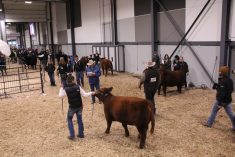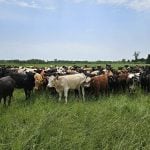Fed Cattle
Global uncertainty resulting from the rapidly changing COVID-19 pandemic has caused all financial and commodity markets to struggle. The cattle markets have not been excluded from this as we have watched the fed cattle price plummet in recent weeks. The fed cattle cash average is $141.54/cwt, which is $22/cwt lower than the high achieved early in the year, and is $13.29/cwt under the same week a year ago. While prices have been steadily decreasing, the basis is actually much stronger than it was a year ago, with the cash-to-cash basis -$10.48/cwt. This compares to -$15.21/cwt. a year ago, indicating that the Canadian spot market remains strong relative to the U.S. market.
Read Also

Body condition, nutrition and vaccination for brood cows
One of the remarkable events of the past century related to ranching has been the genetic evolution of brood cows….
Efforts to slow the virus’s spread have shifted consumer behaviours. Travel bans, school closures and gathering limitations as well as restrictions for restaurant operations have led to reduced food industry beef movement and an increase in retail or grocery store sales. For the beef market, this means different cuts of beef will be more in demand. An increased demand for end cuts and grinding and trim products has been steady, while demand for middle or more expensive steak-type cuts has been lighter.
Slaughter numbers in Canada continue to be above year-ago levels. Steer slaughter is up seven per cent to 292,151 head, while heifer kill in Canada is down four per cent at 166,335 head. Export totals to date of fed cattle, including cows, are 11 per cent higher to the end of February, at a total of 88,302 head.
Deb’s outlook for fed cattle: The entire commodity market is navigating through unprecedented territory because of COVID-19. Continued volatility in the fed cattle market will be the norm while all markets continue to be in upheaval due to the ever- changing global pandemic situation. Changes in Canada over the last few days to business operations will affect the economy in the coming weeks and possibly months. A shift in consumer behaviour will hopefully lead to increased retail beef sales; however, it’s uncertain how much household income changes will shift spending habits. Lower retail prices and increased retail sales should keep cattle moving through the system in the coming months. One additional risk to the fed market is the potential disruption in the supply chain if labour is impacted at the packing plant level. Trade issues are also possible if cross border movement is affected, along with exports to overseas markets. A positive for the beef business is that the low Canadian dollar should help support the fed price and export demand for boxed product. In the near term, expect more volatility and hopefully some stability coming in the not-too- distant future.
Feeder Cattle
Following several negative moves on the feeder futures board, the cash market has followed suit. In recent weeks almost all classes of cattle are lower, with the largest drops seen in the heavier feeders and in heifer trade.
Optimism for a spring grass market has helped soften the effect of the economic uncertainty to the lighter-weight steers. The 550-lb.-feeder steer price at mid-March was $230.71/cwt, which is a $2.90/ cwt drop in the past month, but is still more than $10/cwt higher than a year ago at the same time. In general, this lighter- weight grass-type feeder market improved through the first quarter of the year; however, the uncertainty in the markets can be seen in the lower move over recent weeks.
The heavier feeder cattle, which are placed against the third quarter, definitely felt the negative tone in the live cattle market, as the price dropped $6.44/ cwt in the past month. That’s down over $18.50/cwt from the high in January to a current average 850-lb. steer price of $170.34/cwt. Compared to a year ago, it is also $5.66 lower. Although volatility in the marketplace has pressured the 850-lb. price lower, the Alberta feeder basis is currently +$5.80 /cwt. Last year, the same week saw a much weaker basis at $-11.97/cwt.
Deb’s outlook for feeder cattle: Losses and increased risk in the fed market will weigh on the feeder market, particularly the heavier feeders. Some optimism surrounding spring grass should offer stability to quality groups of grasser-type calves; however, the nervousness and uncertainty will continue to plague the entire cattle industry. It’s completely unknown how the current situation in the world will affect the beef market in the longer term. It’s to be hoped this is short-lived and employment interruptions do not compromise the spending ability of the consumers. In the near term, auction market volumes will decrease, and feeder availability will be lighter.
Non-fed Cattle
Although not following a normal seasonal trend, the non-fed cattle prices in Canada have fared much better than the other classes of beef cattle in recent weeks. Retail demand for grinding products as consumers increase grocery spending in recent weeks has supported cull cattle prices. In addition, volumes of available cows are lower as held-over cows have already moved and ranch cows are heavy in calf or have calves at side. D1,2 cow price average in mid-March was $85.79/ cwt, which is $0.85/cwt higher than the same week a year ago.
Butcher bull prices were slightly higher in recent weeks. The average as of mid-March was at $104.35/cwt, also $0.85 higher than a year ago.
Looking at slaughter rates, cow slaughter is down 11 per cent, totalling 106,061 head. Meanwhile bull slaughter is eight per cent higher than a year ago at 2,106 head. Bull exports to date are also higher, up four per cent to 4,889 head.
Deb’s outlook for non-fed cattle: Seasonally, as well as with COVID-19 spending trends, the demand for grinding and trim meats is expected to be strong, which should support cow prices. The lower Canadian dollar will also support the cull cattle market in Canada. Given that there are no interruptions in packing plant operation, non-fed cattle prices should be generally steady.
















